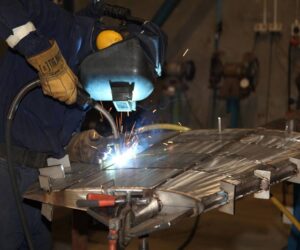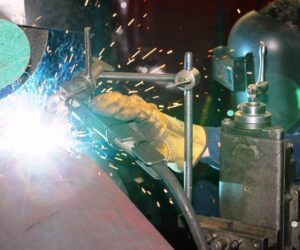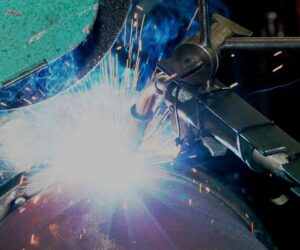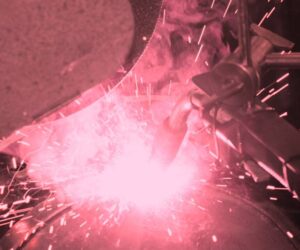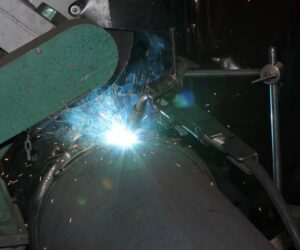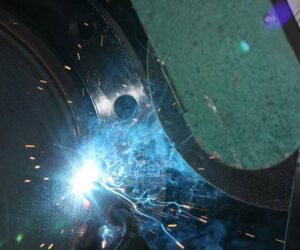High quality, specialised welding services that has come about from our vast experience of casting alloys in our own in-house foundry and performing manufacture and/or repairs of exotic alloys has created a vast level of experience amongst our staff who can repair the most complicated of alloys.
VEEM Limited offers a complete specialized service in:
- Gas Metal Arc Welding (GMAW)
- Gas Tungsten Arc Welding (GTAW)
- Gas Tungsten Arc Welding Hot Wire (GTAW Wire)
- Manual Metal Arc Welding (MMAW)
Our specialised welding services
- Gas Metal Arc Welding (GMAW)
Gas metal arc welding (GMAW) is a welding process in which an electric arc forms between a consumable metal inert gas (MIG) wire electrode and the workpiece metals. This process heats the workpiece metals, causing them to fuse (melt and join). Along with the wire electrode, a shielding gas feeds through the welding gun, which shields the process from atmospheric contamination.The process can be semi-automatic or automatic. A constant voltage, direct current power source is most commonly used with GMAW, but constant systems as well as alternating current, can be used. There are four primary methods of metal transfer in GMAW, namely globular, short-circuiting, spray and pulsed-spray. - Gas Tungsten Arc Weldng (GTAW)
Gas tungsten arc welding (GTAW, also known as tungsten inert gas (TIG) welding, is an arc welding process that uses a non-consumable tunsten electrode to produce the weld. The weld area and electrode are protected from oxidation or other atmospheric contamination by an inert shielding gas (argon or helium). A filler metal is normally used, though some welds, known as autogenous welds or fusion welds do not require it. When helium is used, this is known as heliarc welding. A constant-current welding power supply produces electrical energy, which is conducted across the arc through a column of highly ionised gas and metal vapors known as a plasma. GTAW is most commonly used to weld thin sections of stainless steel and non-ferrous metals such as aluminium, magnesium and copper alloys. The process grants the operator greater control over the weld than competing processes such as shielded metal aerc welding and gas metal arc welding, allowing for stronger, higher quality welds.
- Gas Tungsten Arc Welding Hot Wire (GTAW)
In the GTAW hot wire process, filler wire is resistance heated until close to the melting point and added to the weld pool behind the tungsten electrode. This allows the filler metal to flow across the weld puddle resulting in an increase of weight of weld deposition. - Manual Metal Arc Welding (MMAW)
Manual metal arc welding (MMAW) is a welding process that creates an electric arc between a hand held, flux-coated, consumable filler wire and the work piece.The arc heat melts the parent metal and filler wire. The flux coating breaks down in the arc to produce a gaseous shield that excludes atmospheric gases from the weld zone. The flux coating also provides a deoxidizing action and forms a slag on the cooling weld.The MMAW welding process needs a suitable and constant current power source (AC or DC), a hand piece, a work clamp, leads and flux-covered consumable electrodes.
VEEM Ltd hold capability in automatic and robotic welding to the highest quality standards as well as manual and fabrication. These services include auto buildup of worn or wearing surfaces and are all relevant to all Australian and international standards.
Alloy Range
Stainless Steels
- Corrosion resistant grades 304, 304L, 316 & 316L
- Duplex Stainless grades 2205, 2507 & 2RK65
- Heat Resisting grades 253Ma, 309s & 310
- Hardenable grades 410, 420, 431 & 440C
Nickel Alloys
- Hastelloy C-22 & 276
- Monel 400
- Inconel 600
- Incolloy 825
Aluminium Alloys
- 600 Series SI MG (Marine grade)
- 400 Series Silicon alloy
Copper Alloys
- Leaded Gunmetal
- Nickel Aluminium Bronze
- Phosphor Bronze
- High Tensile Brass
- Cupro Nickel
- Manganese Bronze
- High Conductivity Copper
- Leaded Bronze
Cobalt Alloys
- Wear Resistant Stellite 6
- Heat Resistant UMCo50
Ferrous Alloys
- Wear Resistant Chrome Iron
- Cast Irons
- Manganese Steels
- Low Alloy Steels 4140, EN36A, 1020
Custom Alloys and Grades
- Custom or special alloy variation made to your specification

